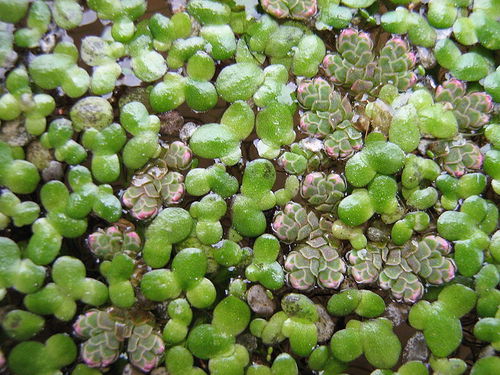Azolla and Duckweed Calculations

Introduction
Consistent with OSE's integrated design approach, we are developing an integrated house and Greenhouse where a separating toilet reclaimed urine to produce duckweed and azola. This duckweed in a Solo may be fed to fish in an aquaponics system, thereby combining wastewater treatment and food production.
To this end, it is important to produce and document design calculations which correlate average human waste production with a required duckweed and azolla system size.
Further, this must consider pond design and existing nitrogen loading from fish if one is to produce an integrated system.
Calculations
Nitrogen-Based First Principle Calculations
- Percentage of protein (nitrogen) in azolla - 25-35% - see link
- Growth rate of duckweed per square meter of surface area - 5 grams dry weight - see duckweed page
- Growth rate of azolla for the same -
- Average grams ammonia produced per person per day - a person needs 2/grams nitrogen, so assume that a person eliminates approximately the same per day.
- Square meters of azolla required to treat an average person's nitrogen loading - 2 square meters roughly.
- Duckweed area required for the same -
- Existing greenhouse - has 224 square feet of trays for growing on the walls - about 20 sq meters.
- say 2 people weigh 300 lb and fish mass is 300 lb - assuming they produce similar amounts of protein - we would need 8 sq meters of azolla to handle the nitrogen loading.
Critique Worth Noting
The downside with a very "tight" nutrient cycle involving humans is the risk of retaining in the system: pharmaceuticals, hormones, microbes/other pathogens. The larger the number of people using this toilet, the higher the likelihood that somebody will be on some antidepressant or birth control pill. Possible solution: dry all waste and burn it. Or grow cattails on the wastewater, dry and burn them. Collect urine with sawdust, dry it, burn it. Collect humanure, dry it, burn it. Use the resulting ashes to fertilize the duckweed/azolla pond. Some nitrogen would be lost but that's OK, it's a minor loss. Urine sawdust could be continuously aerated to keep it dry (to prevent bad smells and nitrous oxide). My suggestion: use human urine and humanure in other ways (e.g. fertilize trees, biomass plants). --Rasmus (talk) 22:32, 13 April 2016 (CEST)